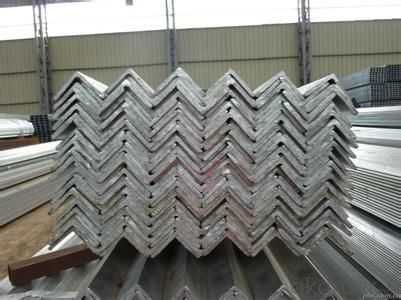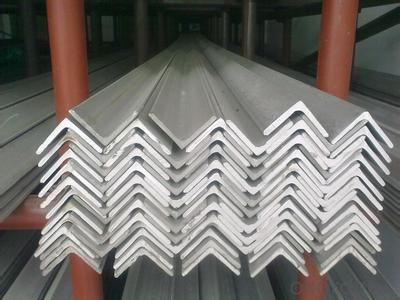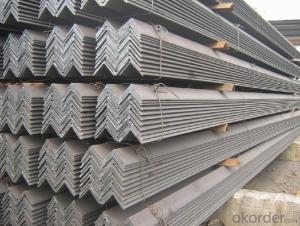High Quality Angle Steel 20-25mm Hot Rolled GB Q235
- Loading Port:
- Tianjin
- Payment Terms:
- TT or LC
- Min Order Qty:
- 25 m.t.
- Supply Capability:
- 20000000 m.t./month
OKorder Service Pledge
OKorder Financial Service
You Might Also Like
Product Description:
OKorder is offering high quality Hot Rolled Steel I-Beams at great prices with worldwide shipping. Our supplier is a world-class manufacturer of steel, with our products utilized the world over. OKorder annually supplies products to European, North American and Asian markets. We provide quotations within 24 hours of receiving an inquiry and guarantee competitive prices.
Product Applications:
According to the needs of different structures, Angle can compose to different force support component, and also can be the connections between components. It is widely used in various building structures and engineering structures such as roof beams, bridges, transmission towers, hoisting machinery and transport machinery, ships, industrial furnaces, reaction tower, container frame and warehouse etc
Product Advantages:
OKorder's Steel I-Beams are durable, strong, and resist corrosion.
Main Product Features:
· Premium quality
· Prompt delivery & seaworthy packing (30 days after receiving deposit)
· Corrosion resistance
· Can be recycled and reused
· Mill test certification
· Professional Service
· Competitive pricing
Product Specifications:
Manufacture: Hot rolled
Grade: Q195 – 235
Certificates: ISO, SGS, BV, CIQ
Length: 6m – 12m, as per customer request
Packaging: Export packing, nude packing, bundled
Sizes: 25mm-250mm | ||||||||||||
a*t | ||||||||||||
25*2.5-4.0 | 70*6.0-9.0 | 130*9.0-15 | ||||||||||
30*2.5-6.6 | 75*6.0-9.0 | 140*10-14 | ||||||||||
36*3.0-5.0 | 80*5.0-10 | 150*10-20 | ||||||||||
38*2.3-6.0 | 90*7.0-10 | 160*10-16 | ||||||||||
40*3.0-5.0 | 100*6.0-12 | 175*12-15 | ||||||||||
45*4.0-6.0 | 110*8.0-10 | 180*12-18 | ||||||||||
50*4.0-6.0 | 120*6.0-15 | 200*14-25 | ||||||||||
60*4.0-8.0 | 125*8.0-14 | 250*25 | ||||||||||
FAQ:
Q1 How do we guarantee the quality of our products?
A1 We have established an advanced quality management system which conducts strict quality tests at every step, from raw materials to the final product. At the same time, we provide extensive follow-up service assurances as required.
Q2 How soon can we receive the product after purchase?
A2 Within three days of placing an order, we will begin production. The specific shipping date is dependent upon international and government factors, but is typically 7 to 10 workdays.
Q3 What makes stainless steel stainless?
A3 Stainless steel must contain at least 10.5 % chromium. It is this element that reacts with the oxygen in the air to form a complex chrome-oxide surface layer that is invisible but strong enough to prevent further oxygen from "staining" (rusting) the surface. Higher levels of chromium and the addition of other alloying elements such as nickel and molybdenum enhance this surface layer and improve the corrosion resistance of the stainless material.


- Q:Can steel angles be used for railings or barriers?
- Yes, steel angles can indeed be used for railings or barriers. Steel angles are commonly used in construction and are known for their strength and durability. They provide a sturdy and reliable structure for railings and barriers, ensuring the safety and security of the area. Steel angles can be easily welded or bolted together, allowing for easy installation and customization. Additionally, steel angles can be coated or painted to enhance their appearance and protect against rust and corrosion. Overall, steel angles are a popular choice for railings and barriers due to their strength, versatility, and longevity.
- Q:Can steel angles be used for HVAC ductwork support?
- Certainly, HVAC ductwork support can indeed be achieved through the utilization of steel angles. In construction endeavors, steel angles are frequently employed due to their commendable resilience and robustness. They offer superb reinforcement for an array of purposes, encompassing HVAC ductwork systems. It is effortless to fashion and deploy steel angles, thereby establishing a steadfast structure for the ductwork, guaranteeing stability and optimal operation of the system. Furthermore, steel angles possess the capacity to endure the weight and force applied by the ductwork while exhibiting resistance against corrosion. Consequently, they prove to be an apt preference for prolonged utilization.
- Q:How do you connect two steel angles together?
- Welding is a commonly used technique for connecting two steel angles. It involves melting the angles' edges and joining them using an electric arc or flame, resulting in a durable and permanent connection. Before welding, it is vital to clean the surfaces to remove any impurities or rust. Furthermore, accurately aligning the angles and securing them with clamps or tack welds is essential to guarantee a precise connection. Another alternative for joining steel angles is using bolts or screws. This approach entails drilling holes through the angles and then fastening them together with nuts and bolts or screws. To achieve a strong connection, it is crucial to choose appropriate fasteners and ensure they are tightly secured.
- Q:Can steel angles be used for foundation supports?
- Yes, steel angles can be used for foundation supports. Steel angles provide structural support and stability, making them suitable for various construction applications, including foundation supports.
- Q:Can steel angles be used as lintels or beams in construction?
- Steel angles can serve as lintels or beams in construction. These versatile structural elements lend support and strength to various kinds of structures. They are commonly utilized in construction projects due to their ability to bear heavy loads and resist bending or warping. When employed as lintels, steel angles are typically positioned horizontally above doors and windows to distribute the weight of the structure above and prevent sagging in the openings. As beams, steel angles can be employed to support floors, roofs, or other structural components. Their durability, versatility, and cost-effectiveness make them a popular choice compared to other materials. Nevertheless, it is crucial to seek advice from a structural engineer or construction professional to ensure that the specific steel angles being used are appropriate for the intended application and adhere to the necessary building codes and standards.
- Q:Are there any limitations on the length-to-thickness ratio of steel angles?
- Yes, there are limitations on the length-to-thickness ratio of steel angles. These limitations are specified in engineering codes and standards, which provide guidelines for the safe design and use of steel angles. The exact limitations depend on factors such as the material properties, intended application, and structural requirements.
- Q:What is the maximum load capacity for a curved steel angle?
- The maximum load capacity for a curved steel angle depends on various factors such as the dimensions and thickness of the angle, the quality of the steel used, and the specific application in which it is being used. Generally, the load capacity of a curved steel angle is determined through structural engineering calculations and analysis. These calculations take into account the material properties of the steel, the curvature of the angle, and any additional loads or forces that will be applied to it. It is important to consult with a qualified structural engineer or refer to relevant design codes and standards to determine the maximum load capacity for a specific curved steel angle in a given application.
- Q:Can steel angles be used in marine environments?
- Yes, steel angles can be used in marine environments. However, it is crucial to select the appropriate grade of stainless steel or corrosion-resistant coating to prevent corrosion and ensure durability in the harsh marine conditions.
- Q:What are the common methods of surface cleaning for steel angles?
- There are several common methods of surface cleaning for steel angles. These methods are used to remove dirt, rust, paint, and other contaminants from the surface of the steel angles, ensuring a clean and smooth finish. One of the most common methods is mechanical cleaning, which involves using abrasive materials such as sandpaper, wire brushes, or abrasive pads to scrub the surface and remove any loose particles or rust. This method is effective for small areas or for spot cleaning. Chemical cleaning is another popular method, which involves using chemicals or solvents to dissolve or loosen contaminants on the surface. This can be done by applying a cleaning solution directly onto the steel angles and then scrubbing with a brush or cloth. Chemical cleaning is useful for larger areas or for removing stubborn stains or paints. Power washing, also known as pressure washing, is another method commonly used for surface cleaning of steel angles. This involves using a high-pressure water jet to remove dirt, dust, and loose particles from the surface. Power washing is efficient for large areas or for removing loose rust or paint. Another method is abrasive blasting, which involves using compressed air to propel abrasive materials, such as sand or steel grit, onto the surface of the steel angles. This method is highly effective in removing heavy rust, paint, or scale from the surface, leaving a clean and smooth finish. It is important to note that the choice of surface cleaning method depends on the condition of the steel angles and the desired level of cleanliness. Some methods may be more suitable for specific applications or may require specialized equipment. Additionally, proper safety precautions should be followed when using any cleaning method, including wearing protective gear and ensuring proper ventilation.
- Q:Can steel angles be used for manufacturing playground equipment?
- Yes, steel angles can be used for manufacturing playground equipment. Steel angles provide strength and stability, making them suitable for constructing various playground structures such as slides, swings, and climbing frames.
1. Manufacturer Overview |
|
|---|---|
| Location | |
| Year Established | |
| Annual Output Value | |
| Main Markets | |
| Company Certifications | |
2. Manufacturer Certificates |
|
|---|---|
| a) Certification Name | |
| Range | |
| Reference | |
| Validity Period | |
3. Manufacturer Capability |
|
|---|---|
| a)Trade Capacity | |
| Nearest Port | |
| Export Percentage | |
| No.of Employees in Trade Department | |
| Language Spoken: | |
| b)Factory Information | |
| Factory Size: | |
| No. of Production Lines | |
| Contract Manufacturing | |
| Product Price Range | |
Send your message to us
High Quality Angle Steel 20-25mm Hot Rolled GB Q235
- Loading Port:
- Tianjin
- Payment Terms:
- TT or LC
- Min Order Qty:
- 25 m.t.
- Supply Capability:
- 20000000 m.t./month
OKorder Service Pledge
OKorder Financial Service
Similar products
New products
Hot products
Related keywords



























